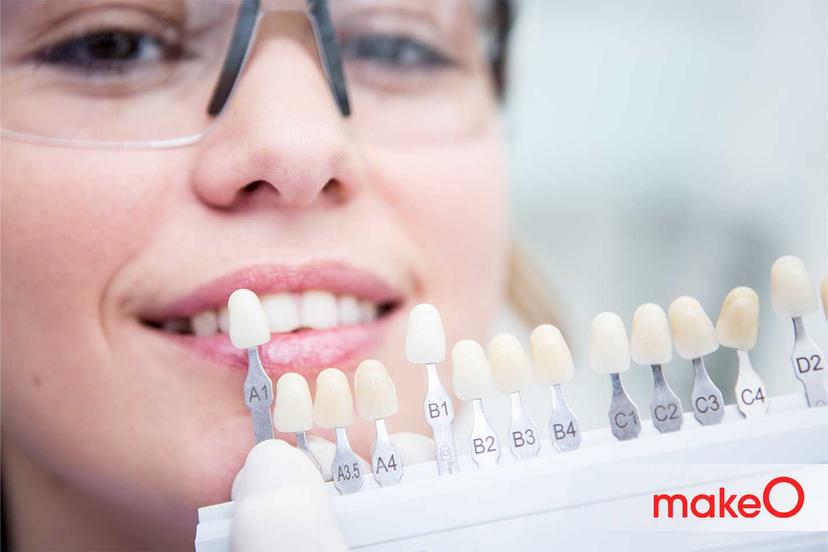MakeO blog
Braces are the most effective way to treat various teeth and jaw alignment issues that can create further dental problems. Braces consist of many orthodontic parts such as brackets and archwires that carry out the teeth straightening process. One such essential part is rubber bands for braces that carry out an important role in your orthodontic treatment.
What are elastics for braces?
The use of elastics for braces can be categorized into two types. One type of orthodontic elastics are the ones that are placed around each bracket in your teeth, also known as ligatures. These elastics around the brackets make sure that the archwire stays intact when placed in the brackets. The other type of orthodontic elastics are the ones that are attached between two brackets, either vertically or horizontally. These elastics may not be necessarily used for treating all teeth correction cases.
Purpose of elastics for braces
Proper Bonding
Orthodontic elastics in the form of ligatures are used to secure the bond between brackets and archwires. The ligatures make sure that the archwire will stay intact in each portion of the bracket on the teeth.
Jaw Alignment
Rubber bands for braces are also used to effectively treat jaw alignment issues. Braces bands are fixed between two brackets through a hook in a vertical arrangement to fix issues such as overbite, underbite, open bite, or crossbite.
Fix Teeth Spacing
When dental elastic bands are attached to your brackets in a horizontal arrangement, they can fix the spacing between your teeth. These elastics can also be used to fix the inward or outward orientation of an individual tooth.
When to use & why to use
Now that you know what elastics for braces are, we will look at when and why they are used with braces. An elastic rubber band for teeth is used to exert more pressure in a precise way on a certain part of your mouth. Fixing a jaw misalignment issue will require more pressure that cannot be applied by brackets and archwires alone. With the use of a dental elastic band, your orthodontist can carry out the required correction more precisely.
Benefits
- Faster Correction
Rubber bands along with your braces will exert the necessary amount of pressure required for severe teeth and jaw misalignment issues. When the required amount of pressure is exerted, the teeth correction process will be carried out within the estimated timeline or even before.
- Even Bite
Almost all of your jaw alignment issues may require the application of rubber bands for braces. This means that a dental elastic band will play a major role in providing a proper and even bite.
How long do you usually wear elastics on braces?
Elastics can be introduced along with your braces depending upon the type and severity of your case. You will have to wear your elastics for the entire day until the end of your treatment as instructed by your orthodontist. However, they can also be removed after the correction process required by the elastics is complete. Elastics for braces play an essential role in fixing various teeth and jaw alignment issues. You can experience effective treatment in a shorter period with the use of elastic bands when required. Now you can truly appreciate the use of such a small but necessary dental appliance in your braces.
FAQs
- What do elastics for braces do?
Elastic for braces will be introduced by your orthodontist if it is required for your teeth correction treatment. The rubber braces will help to add extra pressure to certain targeted areas in your mouth which cannot be done through braces alone. These rubber braces are attached to the hooks in the brackets and are also used to correct different jaw alignment issues.
- Do braces elastics hurt?
In the initial stages of elastics being introduced to your braces, you may experience slight discomfort in your mouth in the form of soreness. This happens due to the constant pressure exerted with the use of elastics on your teeth and jaw.
- Are elastics the last stage of braces?
Yes, elastics can be considered as the last stage of braces as they carry out the requirement of the extra pressure that is required. After the elastics are introduced, you don’t require any other dental appliance to carry out your treatment.
related categories
Related articles

Types of Braces: Removable vs Fixed Braces, Which is Right For You?

This Diwali, Smile Bright With makeO Teeth Whitening Kit

Dr. Pravin Shetty: Pioneer in Lingual Orthodontics & Innovative Smile Solutions
How do I Know I’m the Right Candidate for makeO toothsi Teeth Aligners?

